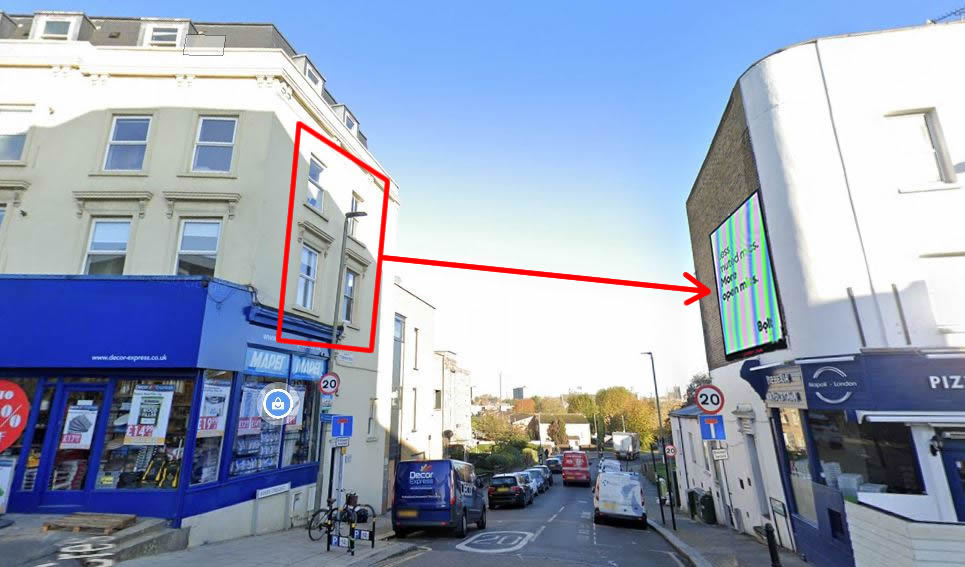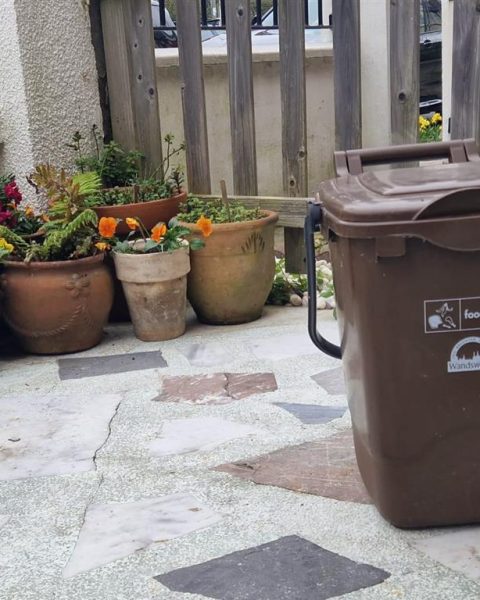Planning Application 2021/4548 has been submitted for erection a digital display screen on the side building of 42 Lavender Hill, on Ashley Crescent’s side of block. The proposal for the façade fronting Ashley Crescent will be highly visible and disturbing for the residents with windows directly fronting the digital display.
Benefits for these sort of display are numerous for the owners: attention-grabbing displays (it is proven to receive more user attention), dynamic contents, instant update, cost effective on the long term (they require no transport costs, no labour costs and no printing costs!). However, there are also several important downsides: expensive initial cost, environmentally unfriendly, and most importantly disturbing for traffic and residents in large urban area (the consequence of receiving more user attention). The National Collaboration Centre for Environmental Health has published a study on Health Effects of Large LED Screens on Local Residents. They found that “screens contribute to the light associated with urban space […] As a bright light source from which the residents have no control, the LED screen may promote annoyance and stress to residents living nearby.“
Detrimental impact on neighbouring residential properties
The application is described as:
Advertisements would appear as static, two-dimensional, illuminated images, which update on an automated 10 second sequential cycle.
Unlike the applicant statement, the advertising board will not face directly a multi-unit DIY decorating business, but windows of habitable rooms, as shown on the photo montage at the top of this article. Although Ashley Crescent leads to a commercial road, this is a small residential street with no shops nor commercial properties
The applicant gave examples of similar advertising displays in other locations in London. However, in all the cases provided, there is no residential properties directly affected by the digital displays on a small residential street:
- 182 Tower Bridge Road. Southwark Council: very large space and no direct view on adjacent properties.
- Shoreditch High Street. Hackney Council: screen directed at an angle facing the main street instead of residential windows.
- 115/121 Finchley Road. Camden Council: not facing any property but open space pavement
- 462 Bethnal Road. Tower Hamlets Council: not facing any property and placed above the roof of adjoining building.
- 52 Chamberlayne Road. Brent Council: directly fronting a large open space with train tracks, yards away from adjacent properties.

- 100 Pentonville Road. Islington Council: Advertising display above the roofs of several adjoining properties.
- 178 Chiswick High Road. Hounslow Council: larger road with high traffic at a major junction
- 64 The Broadway Wimbledon. Merton Council: display above adjoining property, not directly fronting any window.
Visually intrusive and additional hazard reducing the attractiveness of this local centre
In addition to the arguments above, it is worth noticing the very thoughtful arguments presented by Lavender Hill For Me residential group. The group notes that there has been efforts for several years “to remove similar advertisements from gable ends and create a more attractive street scene and town centre (for example, adverts have successfully been removed on the side of buildings on nearby Tipthorpe Road, Stormont Road and Rush Hill Road)“. And while the applicants refer to a previous static advert on the wall, this was removed 13 years ago and the wall carefully restored. While this sort of digital advertising is more suited to busy main roads, this area is “characterised by numerous bars and cafes with external pavement seating, which is developing as a local leisure destination” and we’ve seen new pavement, restauration of Victorian features and efforts to attracts shops, to enhance the attractiveness of the area.
Unlike large retail zones where this type of advertising might be appropriate, the applicant is wrong in denying any impact on the surrounding area and asking the Council to consider only the impact on the highway. This is a complex junction on an important cycle route and recent events have highlighted the needs of improvement (see changes a few yards away following a fatal accident on Lavender Hill).
To summarize, there will be a specific detrimental impact on the residential properties directly facing the advertising display, will cause additional hazard to pedestrian and cyclists and will undermine the efforts to enhance the attractiveness of this part of the borough.
Therefore, the proposal is deemed to be inappropriate and should be refused by Wandsworth Council.
UPDATE 16/12/2021: Proposal for the big illuminated digital display refused by officers on 29/11/2021 and labelled as visually intrusive and unsympathetic feature. Reason given in full:
The proposed illuminated advertisement would by reason of its size,
height and prominent location result in a visually intrusive and
unsympathetic feature to the existing property and the streetscape to the
detriment of the local visual amenity. Furthermore, due to the location,
scale and illumination, the proposed advertisement would be an obtrusive
form of development that would result in harm to the amenity of
neighbouring occupiers. The proposal would therefore be contrary to
policies DMS1 and DMS8 of the Development Management Policies
Document (2016) and paragraph 136 of the NPPF 2021.

















